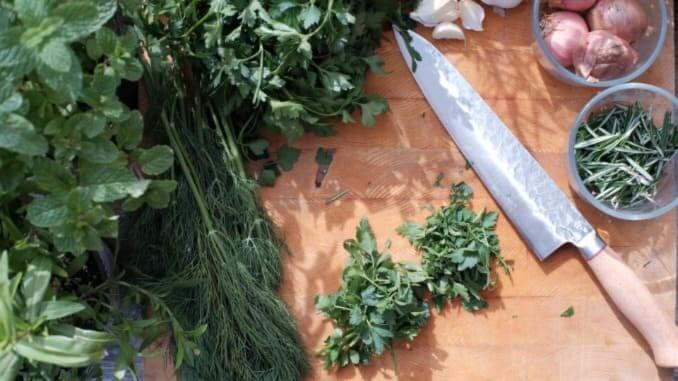In Some Parts of the World, Herbs Aren’t Used as Garnishes—They’re the Stars of the Show
Photo by Kevin Doran/Unsplash
One thing that northern Iran and my grandmother’s backyard in western India have in common is the rich soil that supports the cultivation of fresh herbs. This lush greenery is what makes some Middle Eastern and South Asian cuisines tick—fresh herbs form the backbone of these cuisines. Very rarely is a dish complete without specks of green in the crevices of a falafel or in a bowl of daal. For many Indians, this means cilantro is present in every dish except for desserts. And for Middle Eastern countries such as Iran, parsley and za’atar take center stage.
Worldwide, a common way—and often the only way, bar a sprig of decor—of eating herbs is through sauces. Every culture has its version of a green sauce: chutney for Indians, pesto for Italians, chimichurri for Argentinians, and zhoug for Yeminis and others. But not every culture lets herbs take the spotlight the way that many South Asian and Middle Eastern cultures do.
“Fresh herbs are built into our culture to the extent that we open up our meal with herbs,” said Fares Kargar, chef and owner of Atlanta-based Iranian restaurants Delbar and Bibi. While Italian restaurants serve fresh bread as you wait for your main course, many Middle Eastern meals commence with herbs. One Persian dish, kuku sabzi, is a frittata-esque omelet made entirely of herbs. Dill, parsley and cilantro along with scallions and spices provide a flavorful, floral element to the egg-based dish. Once cooked, kuku sabzi is served with crushed walnuts and pomegranate as garnish.
In many parts of South Asia and the Middle East, herbs are more than a garnish—they’re non-negotiable. Street food vendors in India will never run out of cilantro to pile onto a plate of chaat (a savory snack prepared in an infinite number of ways). Tea stalls may run out of milk but will never be out of mint, a popular addition to both chai and biryani in most regions of India and Pakistan.
Cilantro and mint are the dream team in South Asian countries. A well-known marriage of these ingredients is chutney: a sauce made of cilantro, mint, garlic, green chilis, lemon juice and salt. Chutney is used as a dip for samosas and aloo tikkis (spicy potato patties) and used as a spread in sandwiches and wraps and even as a side dip with the usual roti and sabzi.
Aside from chutney, this combination of cilantro and mint is found in the region’s most beloved street food, called pani puri (also known as gol gappe). Small puris (unleavened bread that puffs up like a ball when deep-fried) are tapped to create a small opening in which a potato and chickpea filling is added along with water. This water isn’t just plain water; it’s made from cilantro, mint and spices. Once you pop this little puri into your mouth, it creates a feeling similar to that of American Gushers (if Gushers were spicy): an explosion of liquid and solid that has you trying to chew the cilantro-mint water and swallow the filling simultaneously.
-

-

-

-

-

-

-

-

-

-

-

-

-

-

-

-

-

-

-

-

-

-

-

-

-

-

-

-

-

-

-

-

-

-

-

-

-

-

-

-








































